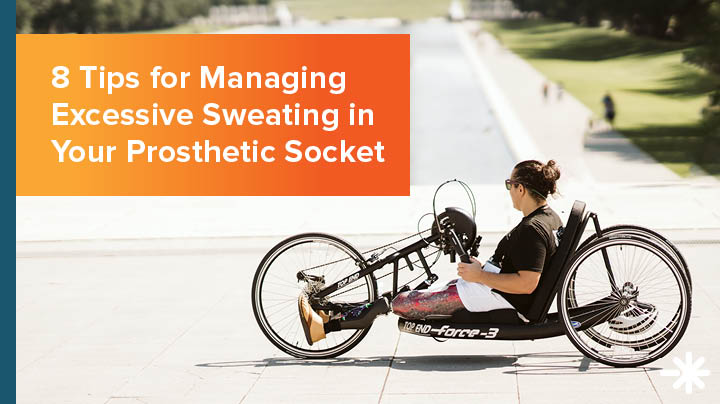8 Tips for Managing Excessive Sweating in Your Prosthesis

Living with a prosthesis can bring unique experiences. One aspect to be mindful of is excessive sweating inside the prosthetic socket, which can lead to discomfort and skin irritation. Prosthetist Wendy Remington Brewer, CPO, shares several strategies you can use to manage and reduce sweating while continuing to stay active, ensuring a more comfortable experience.
1. Optimize Socket Fit
Your prosthetist can provide valuable guidance on managing sweating and ensuring a proper fit for your prosthesis.
Wendy shared, “The best strategy for ensuring that you have the least amount of perspiration in your socket is having the best socket fit. Attend regular follow-ups with your clinician every 3-6 months, make sure your supplies are in good condition, and check to be sure your prosthesis fits well. Friction causes sweat and sweat then leads to more friction. We want to make sure everything fits nice and intimately to reduce any extra friction within your socket.”
2. Use Moisture-Wicking Liners
Prosthetic liners are designed with special wicking fabrics that pull moisture away from your skin and into the liner material. This helps prevent sweat from pooling directly against your residual limb.
“There are different types of liners and suspension systems as well as a sheath or a textile that you might be able to wear underneath your liner to help prevent excessive sweating,” said Wendy.
3. Apply Antiperspirants
Over-the-counter antiperspirants or those specifically formulated for amputees can help control sweat buildup.
Wendy said, “Consider selecting a fragrance-free option to avoid skin irritation and using it overnight. Brands such as Gillette Clinical and Secret Clinical can be good options.”
4. Dress for Sweat Control
Wear lightweight, loose-fitting clothing made from breathable fabrics like cotton. Athletic clothing designed to wick moisture away from the skin can also be beneficial. Carrying extra clothing can help you stay fresh and comfortable throughout the day.
5. Maintain Good Hygiene
Regularly clean your prosthetic socket, liners, and socks to prevent bacterial growth and odors. Use mild soap and water and ensure everything is thoroughly dried before use.
6. Use Powders and Lotions
“Powders and lotions designed for amputees can help control moisture and reduce friction. These products can be applied to your residual limb and inside the socket to keep things dry and comfortable,” said Wendy.
7. Consider Medical Treatments
Wendy continued, “Some physicians may recommend medical treatments such as Botox injections to manage excessive sweating. Each of these solutions has its own indications and contraindications, so it is important to discuss these options with your physician and prosthetic provider.”
8. Drying Towel
Prosthetic sockets and liners are generally airtight and can trap perspiration, leading to excess movement in the system which can cause discomfort. On hot days or when engaging in activities, consider having a moisture-wicking towel on hand. If needed, you can remove the prosthesis to cool, towel dry the limb and prosthesis, and then reapply the prosthesis.
Staying Active with your Prosthesis
Remember, sweating is a natural part of life for everyone, and staying active and moving with your prosthesis is important to maintaining a healthy lifestyle. If you are looking for activities to help you stay active, we encourage you to explore these exercises:
We hope you find incorporating these eight tips can help you better manage excessive sweating and enjoy a more comfortable experience with your prosthesis. For additional assistance, work with your Hanger Clinic prosthetist to find the best solutions for your needs.
Do you have any questions that you would like to have answered? You can submit your questions at hclinic.info/OPQuestions.
Request a Free Evaluation
If you or someone you love is looking for personalized care following amputation, get in touch with a board-certified prosthetist at a Hanger Clinic near you.
Latest Updates
Subscribe to stay up-to-date on our latest posts.


